William ap Thomas
Sir William ap Thomas Kt (died 1445) was a Welsh nobleman, politician, knight, and courtier. He was a member of the Welsh gentry family that came to be known as the Herbert family through his son William Herbert, 1st Earl of Pembroke (8th creation) and is the agnatic ancestor, via an illegitimate descendant of the 1st Earl of the 8th creation, of the current Herbert family of the Earl of Pembroke and Montgomery, and also of the Herbert Earl of Carnarvon.
William ap Thomas | |
|---|---|
_-_geograph.org.uk_-_710370.jpg) The tomb of William ap Thomas | |
| Died | 1445 London |
| Resting place | Abergavenny Priory, Abergavenny |
| Occupation | Politician, Knight, Courtier |
| Title | Sir |
| Spouse(s) | Elizabeth Bluet, Gwladys ferch Dafydd Gam |
| Children | 4 (including William Herbert, 1st Earl of Pembroke) |
| Parent(s) | Sir Thomas ap Gwyllym (died 1438) Maud Morley |
_(cropped).jpg)
Raglan manor, attained through marriage through heiress Elizabeth Bluet, was greatly expanded by William and his son, William Herbert, into the well-fortified Raglan Castle, one of the finest late medieval Welsh castles.
William served King Henry V of England during his first French campaign and in numerous subsequent capacities and was knighted in 1426.
Early life
William ap Thomas was the son of Sir Thomas ap Gwyllym, Knt (d. 1438) of Perth Hir (see Clytha Park) and Maud Morley, daughter and co-heir of Sir John Morley of Llansantffraed. In 1400 Thomas and his wife Maud inherited Llansantffraed Court, the country seat and estate of Sir John Morley.[1][2] Llansantffraed Court was located approximately 2 miles (3.2 km) west of the town of Raglan and Raglan Castle,[3] near Clytha and Abergavenny, Wales.[2][lower-alpha 1]
Later Herbert family pedigrees tracing the family's ancestry to a natural son[4] of Henry I of England have been largely discounted as forgeries,[5] and the dynasty is now considered to be of native Welsh origin, likely as a cadet branch of the pre-Norman Royal Family of the Kingdom of Gwent.[5][6]
The Blue Knight of Gwent
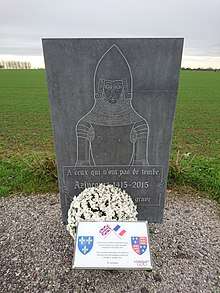
Sir William was thought by antiquarians to have fought at the battle of Battle of Agincourt and Joseph Edmondson (died 1786) states that Sir William was made knight banneret on the battlefield by Henry V. More recent research of the rolls, however, of those who went to France has failed to reveal his name.[7] and a primary source for Edmondson's assertion has not been found. It is possible he was in the entourage of his future wife's father Davy Gam, who fell at Agincourt. Primary sources exist to show that he was made a Knight Bachelor by Henry VI in 1426;[8] and—as Octavius Morgan (died 1888) pointed out—he could not have been knighted twice.[9] He became known to his compatriots as "Y marchog glas o Went" (the Blue Knight of Gwent), because of the colour of his armour.[10][11]
William gradually began to establish himself as a person of consequence in South Wales, and held the following positions:[11]
- William was Steward of the Lordship of Abergavenny by 1421.
- He was appointed High Sheriff of Cardiganshire and Carmarthenshire in 1435.
- In 1440, he was appointed the position as High Sheriff of Glamorgan.
- In 1442 or 1443, William became Chief Steward of Richard Plantagenet, 3rd Duke of York's estates in Wales.
- Was a member of the Duke of York's military council.
While William played an active role for the Duke of York, his sphere of influence was generally limited to South Wales.[11]
Death and burial
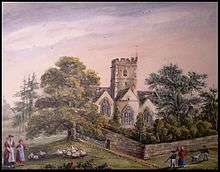
William ap Thomas died in London in 1445 and his body was brought back to Wales.[11] Gwladys and her husband William ap Thomas were patrons of Abergavenny Priory where they were both buried; their alabaster tomb and effigies can still be seen in the church of St Mary's.[12][13][14] [15]
Family
William married firstly in 1406 Elizabeth (died 1420[11]),[lower-alpha 2] the daughter of Sir John Bluet of Raglan manor and widow of Sir James Berkeley. Elizabeth, "the lady of Raggeland",[16] inherited Raglan Castle with her husband James Berkeley, who later died in 1405 or 1406.[11][16][12][17][18] Before marrying Berkeley she had married and become the widow of Sir Bartholomew Picot. Elizabeth's third marriage, to William, was childless.[18]
William married secondly heiress Gwladys ferch Dafydd Gam (died 1454[11]), described by Welsh poet Lewys Glyn Cothi as 'The Star of Abergavenny' for her beauty. She was the daughter of Sir Dafydd Gam and the widow of Sir Roger Vaughan of Bredwardine. All three men had been part of the Welsh contingent that fought with King Henry V of England in France, including the Battle of Agincourt.[1][12][13]
William and Gwladys had children:
- William Herbert, 1st Earl of Pembroke (1423–1469) took the surname Herbert.[13][19] William's allegiance to Richard, Duke of York, and Richard Neville, 16th Earl of Warwick, branded him Edward IV's Welsh "master-lock". He was the first full-blooded Welshman to enter the English peerage and he was knighted in 1452. He married Anne Devereux, daughter of Sir Walter Devereux, in 1449, and they had issue.[20] The modern Herbert family that holds the earldoms of Pembroke, Montgomery, and Carnarvon, are descended from an illegitimate son of this William Herbert.
- Sir Richard Herbert of Coldbrook, near Abergavenny; died on the battlefield of Danesmoor in 1469.[13][19]
- Elizabeth married Sir Henry Stradling[13][19] (1423–1476), son of Sir Edward Stradling (d. c.1394) and Gwenllian Berkerolles, sister and co-heir of his neighbour, Sir Lawrence Berkerolles. Reversing alliances from the previous generation, Henry and his brothers-in-law were hostile to the Henry VI reign. Henry went on a pilgrimage to the Holy Land in 1476. Henry died on 31 August 1476 on his journey back to England and was buried at Famagusta, Cyprus. Thomas, Elizabeth and Henry's young son, died on 8 September 1480.[21]
- Margaret married Sir Henry Wogan,[13][19] steward[22] and treasurer of the Earldom of Pembroke, tasked with securing war material for the defence of Pembroke Castle.[23] Henry and his father, John Wogan of Picton, witnessed an act of Bishop Benedict in 1418. Their son, Sir John Wogan, was killed at the battle of Banbury in 1465, fighting by the side of his uncle, William Herbert, Earl of Pembroke.[24]
Other children less consistently attributed to Gwladys and William include: Maud, Olivia, Elizabeth (who married Welsh country gentlemen, John ab Gwilym),[13] and Thomas Herbert.[19]
The Cornish family of Thomas (Thomas of Lelant, Thomas of Crowan, Thomas of Tremayne, Thoms, and the Bosarvanes of St Just), all patrilineally descended from "Richard Thomas gent. of Wales" are acknowledged as legitimate agnatic descendants of William ap Thomas in the 1620 Visitation of Cornwall.[25]
The Visitation records state "This coate of Pr pale nebule Ar. B. was ye coate armor of Sr Willm ap Thomas, from whom this familye chalengeth to be descended."[25]
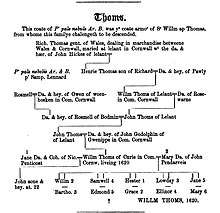
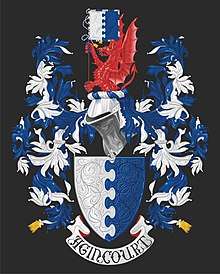
Descendants of this family include Members of Parliament, such as John Thomas who sat in the 1555 Parliament for the Cornish borough of Mitchell,[26] members of the clergy such as Methodist minister the Reverend William Courtenay Thomas[27] and his descendants,[28] and related pioneering families in Australia.[29]
Raglan Castle
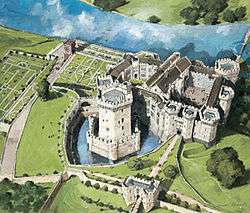
When Sir John Bloet died, Raglan manor passed to Elizabeth Bloet and her husband James Berkeley.[17][30] When William's wife Elizabeth died in 1420, Elizabeth's son Lord James Berkeley inherited Raglan Manor. William resided at Raglan manor as a tenant of his stepson[16] until 1432 when he purchased the manor[17] from Lord Berkeley.[11][16]
Grandiose expansion for defence and comfort occurred between 1432 when William ap Thomas bought the manor and 1469 when his son, Sir William Herbert, was executed. Improvements by father and son included the twin-towered gatehouse, five storied Great Tower encircled by a moat, a self-contained fortress in its own right, South Gate, Pitched Stone Court, drawbridge and portcullis.[16][17]
Thomas Churchyard praised Raglan Castle in his 16th century poem, The Worthiness of Wales:[31]
- "The Earle of Penbroke that was created Earle by King Edward the four bult the Castell sumptuously at the first
- Not farre from thence, a famous castle fine
- That Raggland hight, stands moted almost round
- Made of freestone, upright straight as line
- Whose workmanship in beautie doth abound
- The curious knots, wrought all with edged toole
- The stately tower, that looks ore pond and poole
- The fountaine trim, that runs both day and night
- Doth yield in showe, a rare and noble sight"
Dafydd Llwyd proclaimed Raglan the castle with its "hundred rooms filled with festive fare, its hundred towers, parlours and doors, its hundred heaped-up fires of long-dried fuel, its hundred chimneys for men of high degree."[32]
Notes
- Sir Thomas is buried in the church where a plaque records his death and that of his successors until 1624.[1] After Sir Thomas' death, Llansantffraed Court passed through William's brother, Philip.[3] In 1449 Philip was given 'advowson of the living' by Sir Edward Nevill, 3rd Baron Abergavenny, and Elizabeth de Beauchamp, Lady of Abergavenny. Llansantffraed Court was held by the Philip's descendants in an unbroken line until the 17th century.[2]
- Elizabeth is also known as Isabel Bluet (also spelled Bloet)[16]
- Nicholas, T. (2000) [1872]. Annals and Antiquities of the Counties and County Families of Wales: containing a record of all ranks of the gentry with many ancient pedigrees and memorials of old and extinct families (Facsimile reprint ed.). Baltimore, MD, USA: Genealogical Publishing.Com. p. 777. ISBN 0-8063-1314-5.
- Gobion, C. "Llansantffraed Court, A Potted History of the House". Llansantffraed Court. Retrieved 25 February 2011.
- Ragland, C (1978). The Raglands: the history of a British-American family. 2.
- Dwnn, Lewys (1846). Page 312, Heraldic Visitations of Wales and Part of the Marches: Between the Years 1586 and 1613, Under the Authority of Clarencieux and Norroy, Two Kings at Arms. W. Rees.
- "The Herbert Family Pedigree". www.ancientwalesstudies.org. Retrieved 15 August 2019.
- "Rethinking the Gwent Pedigrees". www.ancientwalesstudies.org. Retrieved 15 August 2019.
- "Sir Harris Nicolas, in his History of the Battle of Agincourt, gives the name of every knight, man-at-arms, and esquire in the army, but does not name any William ap Thomas" (Morgan 1872, p. 50)
- (Morgan 1872, p. 50) cites Leland's Collectanea, Vol. II., p. 491, in a copy made out of a "booke of Chroniques in Peter College Library".
- Morgan 1872, p. 50.
- Clark, Arthur (1962). The Story of Monmouthshire, Volume 1. Christopher Davies. p. 122. ISBN 978-0-9506618-0-3.
- Cadw (1994). Guidebook for Raglan Castle (Section transcribed at CastleWales.com). Cadw. Retrieved 25 February 2011.
- Fanthorpe, L; Fanthorpe, P (2005). The World's Most Mysterious Castles. Toronto: Dundurn Press. ISBN 1-55002-577-5.
- Prichard, T. J. Llewelyn. (2007) [1854]. The Heroines of Welsh History: Or Memoirs Of The Celebrated Women Of Wales (Reprinted ed.). Kessinger Publishing, LLC. ISBN 978-1-4325-2662-7.
- "Abergavenney Priory-William ap Thomas, Sir". Aberystwyth University. Retrieved 7 February 2011.
- "St. Mary's Priory of Abergavenny, William ap Thomas and Gwladys Monuments". St Mary's Priory Church. 2008. Archived from the original on 12 November 2010. Retrieved 7 February 2011.
- Hull, L (2006). Britain's Medieval Castles. p. 160. ISBN 978-0-275-98414-4.
- Newman, J (2000). The Buildings of Wales: Gwent / Monmouthshire. London: Penguin Books. pp. 16, 17, 490, 589. ISBN 978-0-300-09630-9.
- Richardson, D; Everingham, K (2004). Plantagenet Ancestry: A Study in Colonial and Medieval Families. Baltimore, MD, US: Genealogical Publishing Company, Inc. p. 100. ISBN 0-8063-1750-7.
- Evans, Howell T. (1915). Wales and the wars of the Roses. Cambridge University Press. p. 244. LCCN 15019453.
- Griffiths, R. A. (2004). "Herbert, William, first earl of Pembroke (c.1423–1469),". Oxford Dictionary of National Biography (Online ed.). Oxford University Press. doi:10.1093/ref:odnb/13053.
- Griffiths, R. A. (2004). "Stradling (Stradelinges, de Estratlinges) family". Oxford Dictionary of National Biography (Online ed.). Oxford University Press. doi:10.1093/ref:odnb/48658.
- "Sloane Charters". Cymmrodorion Record Series. London: Honourable Society of Cymmrodorion. 4: 618. 1908.
- Evans, Howell T. (1915). Wales and the wars of the Roses. Cambridge University Press. p. 214. LCCN 15019453.
- Owen, Henry (1902). Old Pembroke Families in the Ancient County Palatine of Pembroke. London: C. J. Clarke. LCCN 05015821.
- "The Visitations of Cornwall". ukga.org. Retrieved 15 August 2019.
- "THOMAS, John II (c.153I-81/90), of the Middle Temple, London and Constantine, Cornw. | History of Parliament Online". www.historyofparliamentonline.org. Retrieved 15 August 2019.
- Joseph A. Alexander (ed.), Who's Who in Australia 1955 (Melbourne: Colorgravure Publications, 1955), p.749.
- "Jeffrey Raeder Thomas - Coat of arms (crest) of Jeffrey Raeder Thomas". www.heraldry-wiki.com. Retrieved 15 August 2019.
- "THOMAS, Edward Courtney". Western District Families. 21 September 2017. Retrieved 15 August 2019.
- Brown, R (1989). Castles From the Air. Cambridge: Press Syndicate of the University of Cambridge. p. 190. ISBN 0-521-32932-9.
- Churchyard, T. "A Description of Monmouth Shiere". Worthiness of Wales. Retrieved 25 February 2011.
- Jones, R (2003). Haunted castles of Britain and Ireland.
References
- Morgan, Octavius (1872). Some Account of the Ancient Monuments in the Priory Church, Abergavenny. Monmouthshire and Caerleon Antiquarian Association. p. 50.CS1 maint: ref=harv (link)